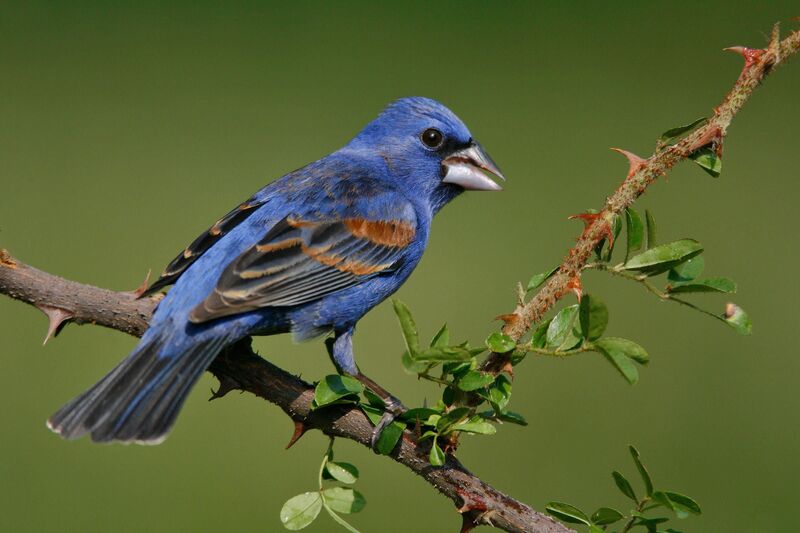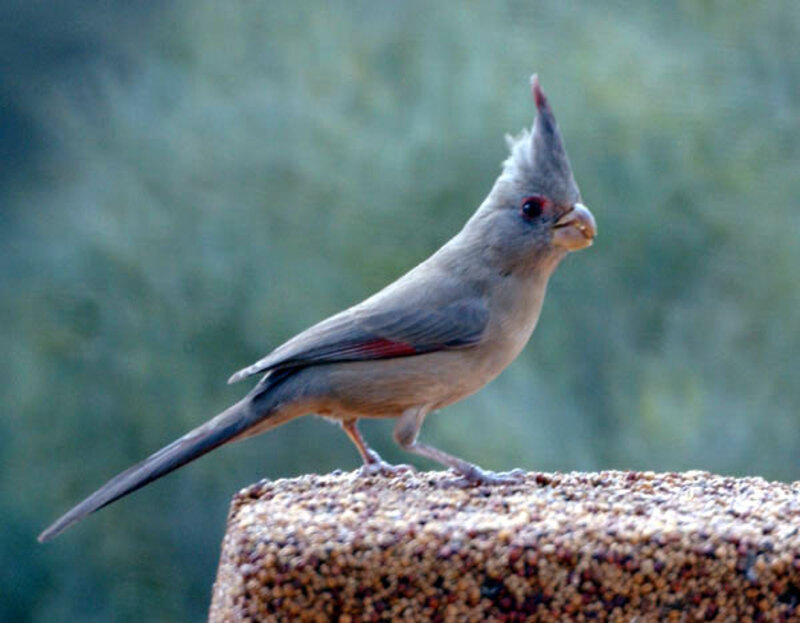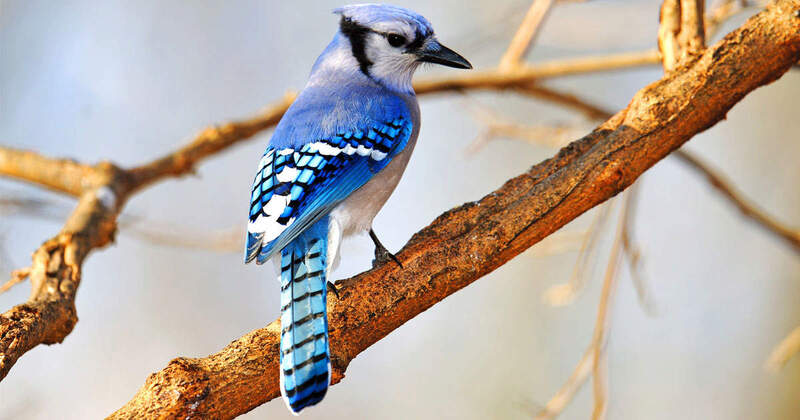Whether you’re new to birdwatching or have been at it for some time, chances are you’ve heard of the elusive blue cardinal and have wondered if this rare bird really exists. Maybe you’re even feeling a little slighted because not one has bothered to visit the many bird feeders you keep stocked with goodies that attract. Well, don’t let it get you down. In fact, it’s time you put your binoculars aside for a moment and let this sink in. It’s all one big myth.
I don’t even know you, but I can sense your disappointment. After all, the vivid northern red cardinals that we so often spot flickering between thickets, the birds that catch our eye so easily on a snowy winter day are certainly beautiful. What a wonder it would be to have the coveted distinction of actually seeing and bringing to life this mythical blue species! In your dreams you probably captured the moment on your trusted digital camera telescope. With that rare image in hand, no one could ever have doubted you.
But many people have claimed to have actually seen this bird. Were they making it all up?

You Say Blue Cardinal. I Say Blue Grosbeak
Do you know the difference between an elk and a caribou? Okay, maybe you do, but you wouldn’t be alone if you didn’t. The point is that it’s not uncommon to mistaken one type of animal for another. And that’s especially true with birds. For one thing, they don’t always sit (or perch) still when you want them to.
A blue grosbeak is one such bird that might be mistakenly identified as our mythic winged friend. The males are noteworthy for their lovely deep blue color and reddish-brown wingbars with a small black mask in front of their eyes, while the females are more of a cinnamon-brown hue. They have large, triangular beaks that appear to take over their entire face. Sized somewhere between that of a sparrow and a robin, these stocky songbirds can be typically found in high grasses and shrubby areas.
In the summer months, you may find the males hanging out and loudly singing their warbling songs. This is how they defend their nesting area. You may see them perched atop the high points of small trees, their tails often twitching in a sideways motion. They leave the nest making to females who build open cup designs usually 3 to 10 feet above the ground and made from twigs, leaves, bark, rootlets and other debris. They then line their nests with a layer of fine grass. A blue grosbeak’s diet consists mostly of insects and seeds. The young, which leave the nest at about 9 to 10 days old, are fed mostly by the female.
The blue grosbeak is similar in size to the typical northern cardinal. It’s also a member of the same family, Cardinalidae. It’s also definitely a blue bird. But it’s not a blue cardinal.

What About the Pyrrhuloxia? Isn’t it Blue? Isn’t it a Cardinal?
If you live in or have visited the American Southwest or northern Mexico and have spotted a pyrrhuloxia, also known as a desert cardinal, you may be forgiven for having thought it was something else. Just look at the photograph of a female on the Wikipedia entry! Despite it’s cardinal crest and bluish tinge, however, these birds are really a brownish gray. The Audubon Society field guide includes a photograph of pyrrhuloxia also, which shows a distinctly gray bird. These two pictures make an excellent argument for how easy it can be to draw the wrong conclusion when you see the same bird under a different light or at a different angle. You’ll want to keep that in mind as you read further.
While pyrrhuloxia belong to the same family as cardinals, grosbeaks and buntings, these songbirds are generally more active and sociable than the southwestern cardinals, and in the winter they may often roam further from their nesting areas. However, they are not considered truly migratory. Pyrrhuloxia females make nests of grass, bark and thorny twigs in shrubby areas or in low trees 4 to 15 feet above the ground in the same types of areas they forage. They feed on a variety of insects, seeds and berries.
Eating is a family affair for pyrrhuloxia, with the male often feeding the female if she is nesting and both bringing food for nestlings once they are born. Females lay on average 3 to 4 eggs with incubation lasting about 14 days. If you wish to attract pyrrhuloxia to your feeder to see their color in person, try including mesquite seeds or sunflower seeds.
If you’re lucky enough to draw them to your feeder, you’ll see that pyrrhuloxia are not blue. Pyrrhuloxia are not blue cardinals.

Not the Blue Jay, Too?
While it may seem a bit of a stretch, it’s possible the common blue jay has also been inaccurately identified as a blue cardinal. Larger, more aggressive and far noisier than the northern red cardinal, the fact that they both have a crest might lead some to the wrong conclusion.
A common bird found in deciduous and mixed woods, the blue jay has adapted well into cities and suburbs. An intelligent bird, it belongs to the same family as crows and magpies. These birds are easily recognized by sight but also by their distinctive cries of jay! jay! They are also quite adept at mimicking other birds including the screams of red-shouldered hawks. Omnivorous, they feed on nuts, berries, seeds, fruits as well as insects, frogs, small rodents, other birds’ eggs and baby birds.
Unlike blue grosbeaks and pyrrhuloxia, blue jay couples work together on their nests, bulky encampments made of grass, twigs, bark as well as scraps of material and string they may encounter in their suburban neighborhoods. Most blue jays stay throughout the year in the same range, but in some years a massive southern migration occurs to the lower United States.
The blue jay is recognizable for its striking blue color and crest with a black border behind it, and its snowy white chest.
Blue jays are indeed beautiful blue birds. They are not, however, blue cardinals.
Still unconvinced?

Is the Sky Blue?
It’s a rhetorical question, of course. After all, everyone knows the sky is blue. Or is it?
All right, I’m going to get a little science-y on you, but hopefully this will help with the discussion. The fact is, the existence of a cardinal that is even slightly bluish is highly unlikely as the color blue is quite uncommon in nature–at least when it comes to pigmentation.
Interestingly, most pigments in the fur, feathers and skin of wildlife are directly related to the kinds of foods they eat. When it comes to birds, goldfinches get their yellow color from their diet of common yellow flowers like dandelions, ragweed and sunflowers. Flamingos get their pink and orange coloring from the beta carotene prevalent in the algae, larvae and brine shrimp in their natural diets. And northern red cardinals get their bright red hues from carotenoid-rich fruits and berries.
Now that doesn’t mean there aren’t some beautiful blues in the bird world. Gorgeous blue macaws and other colorful parrot species come immediately to mind, not to mention the blue jays mentioned earlier.
So that must mean these birds eat a lot of blueberries, right?
No. Blueberries and other foods with blue pigments are eliminated when birds eat them. Blue-feathered birds don’t get their color from pigment but rather from the way their feathers reflect light.
It’s a Structural Thing
According to Scott Sillett, wildlife biologist with the Smithsonian Migratory Bird Center, there is no such thing as a blue bird.
Say what?
Let’s back up a bit. As noted earlier, red and yellow feathers draw their color from pigmentation, but blue feathers do not. The blue feathers of blue jays and blue birds and the like are made up of protein molecules called keratin, and the varying ways these keratin structures reflect light determines the different shades of blue we humans see.
Yale ornithologist Richard Prum describes it a little more technically. Keratin and water are a lot like oil and vinegar. They don’t mix. So when a blue feather grows, the keratin in each of the feather’s cells separate from the water leaving a mix of keratin and air pockets. Think of it like the holes in a sponge. When white light then hits a blue feather, the keratin structure causes the red and yellow wavelengths of light to cancel each other out, while allowing the shorter blue wavelengths to become amplified and reflect back on our human eyes. Where the red we see in a cardinal’s crest is a pigmented color, the blue we see here is a structural color.
Don’t believe any of it? The next time you’re out birding and happen along a blue jay feather, try backlighting it to see how the feather appears. You may be surprised to see it looks brown. That’s because you will only be seeing the melanin in the feather rather than the reflection of the sun’s blue light.
By the way, the same reflection of light explanation can be said of the blues we see in bluebells, hydrangeas and other blue-flowering plants. It’s all about structure. Plants do not have actual blue pigments either.
So There You Have It
There’s no way around it. The elusive blue cardinal does not exist. But then again, the next time the subject comes up with your bird-watching friends, you can one-up them and let them know that in the truest-bluest sense, blue birds of any kind don’t exist either. And that’s got to be worth something. Right?
Related
- While blue may not always be nature’s favorite color, orange is all the rage. Read up on orange bellied birds for the next time you go out bird watching.
- Human beings tend to be monogamous, but how about birds like cardinals? Read up in our article “Do Cardinals Mate For Life?”.
- Interested in birding? Check out our beginners guide to birding and get started.
I live the Delmarva Peninsula, just below the Delaware border. About 25 years ago, I drove up to an intersection, and standing in the road was a bird that was blue, but was shaped like a cardinal. When I say blue, I mean a single shade of blue, like the top half of a blue bird. He/she was not shaped, nor colored like a Blue Grosbeak or Steller’s Jay. He had the tufted crest on his head and the round body of a cardinal. Picture a standard, ordinary Cardinal, except for being a single shade of blue. On each wing were two small bright-red stripes, as if he was a corporal in the Marines. Ever since, I have searched for the name of such a bird, but it seems that no such bird exists. Was he a mutant? A hallucination? I don’t use drugs. I don’t drink alcohol. He flew away leaving me with this annoying memory. Any clues?